K151545 Law Assignment: Analysis of Misrepresentation and Negligence
VerifiedAdded on 2021/06/18
|9
|2427
|94
Homework Assignment
AI Summary
This assignment, completed by student ThiThuy Trinh Vo, addresses two key legal issues: misrepresentation in contract law and negligence. The first question examines a scenario where Jessica allegedly misrepresented the annual profits of her restaurant to Angela, leading to a contract of sale. The analysis delves into the elements of misrepresentation, including a false statement of fact, inducement, and reliance. The second question explores a negligence case involving Smiths, Andy, and Sandra, who purchased a carton of cola from a local store. The assignment analyzes the duty of care owed by manufacturers, suppliers, and retailers, referencing the principles established in Donoghue v Stevenson. It assesses whether the store owner breached their duty of care by selling a product containing a foreign object (cockroach remains), leading to Andy's injury and potential liability for damages. The assignment applies legal principles to the facts, evaluating the chances of success for the parties involved in pursuing legal action.
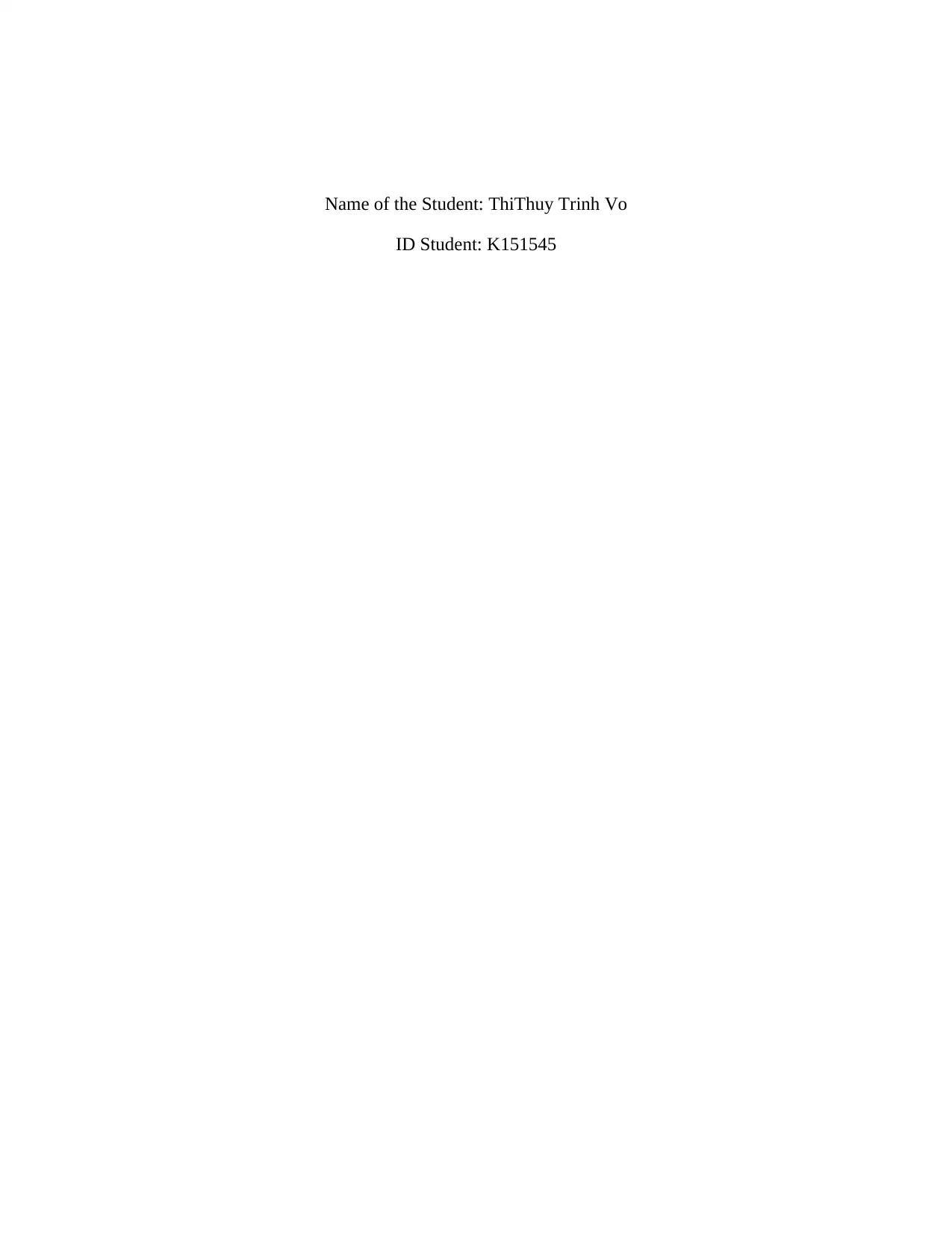
Name of the Student: ThiThuy Trinh Vo
ID Student: K151545
ID Student: K151545
Paraphrase This Document
Need a fresh take? Get an instant paraphrase of this document with our AI Paraphraser
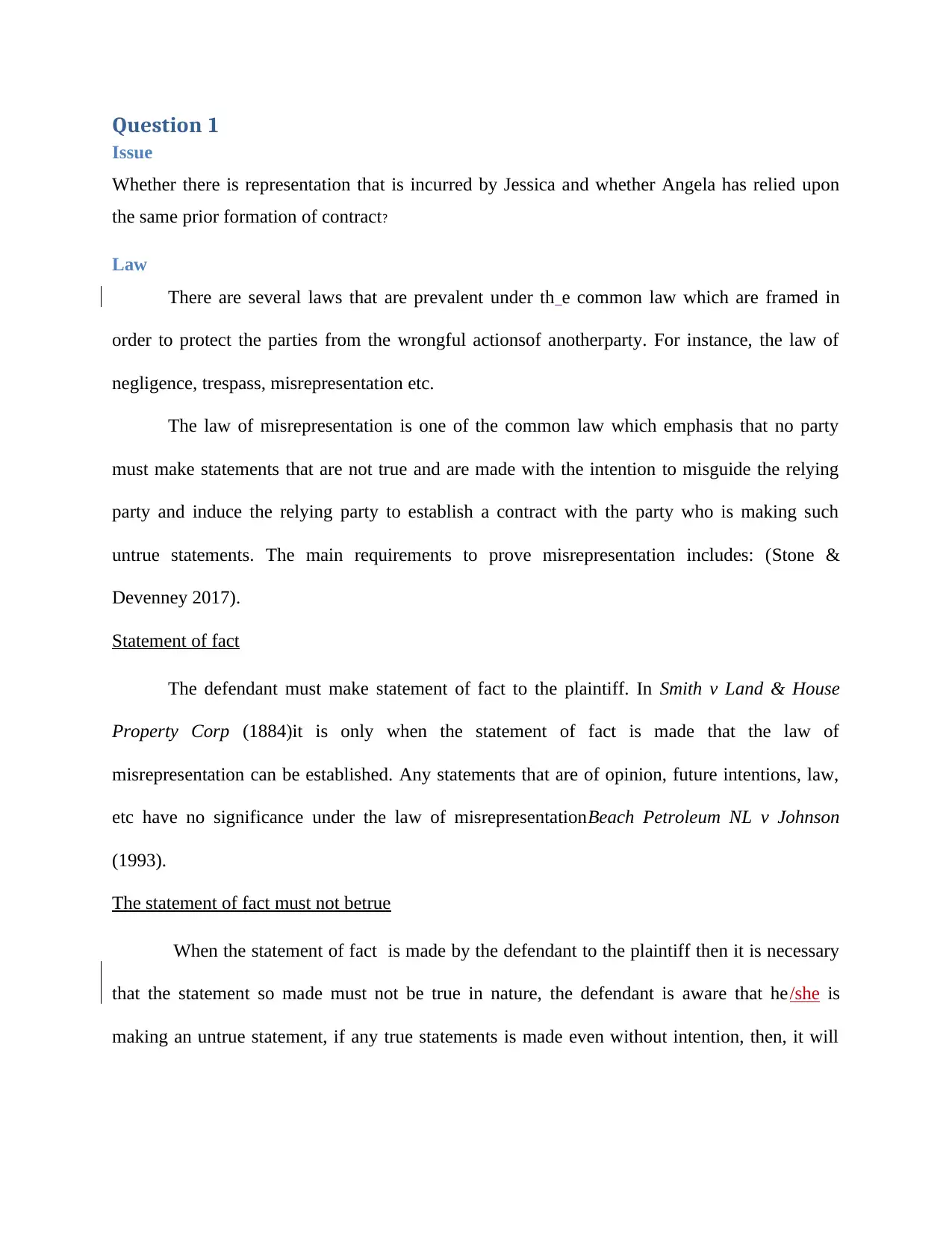
Question 1
Issue
Whether there is representation that is incurred by Jessica and whether Angela has relied upon
the same prior formation of contract?
Law
There are several laws that are prevalent under th e common law which are framed in
order to protect the parties from the wrongful actionsof anotherparty. For instance, the law of
negligence, trespass, misrepresentation etc.
The law of misrepresentation is one of the common law which emphasis that no party
must make statements that are not true and are made with the intention to misguide the relying
party and induce the relying party to establish a contract with the party who is making such
untrue statements. The main requirements to prove misrepresentation includes: (Stone &
Devenney 2017).
Statement of fact
The defendant must make statement of fact to the plaintiff. In Smith v Land & House
Property Corp (1884)it is only when the statement of fact is made that the law of
misrepresentation can be established. Any statements that are of opinion, future intentions, law,
etc have no significance under the law of misrepresentationBeach Petroleum NL v Johnson
(1993).
The statement of fact must not betrue
When the statement of fact is made by the defendant to the plaintiff then it is necessary
that the statement so made must not be true in nature, the defendant is aware that he/she is
making an untrue statement, if any true statements is made even without intention, then, it will
Issue
Whether there is representation that is incurred by Jessica and whether Angela has relied upon
the same prior formation of contract?
Law
There are several laws that are prevalent under th e common law which are framed in
order to protect the parties from the wrongful actionsof anotherparty. For instance, the law of
negligence, trespass, misrepresentation etc.
The law of misrepresentation is one of the common law which emphasis that no party
must make statements that are not true and are made with the intention to misguide the relying
party and induce the relying party to establish a contract with the party who is making such
untrue statements. The main requirements to prove misrepresentation includes: (Stone &
Devenney 2017).
Statement of fact
The defendant must make statement of fact to the plaintiff. In Smith v Land & House
Property Corp (1884)it is only when the statement of fact is made that the law of
misrepresentation can be established. Any statements that are of opinion, future intentions, law,
etc have no significance under the law of misrepresentationBeach Petroleum NL v Johnson
(1993).
The statement of fact must not betrue
When the statement of fact is made by the defendant to the plaintiff then it is necessary
that the statement so made must not be true in nature, the defendant is aware that he/she is
making an untrue statement, if any true statements is made even without intention, then, it will
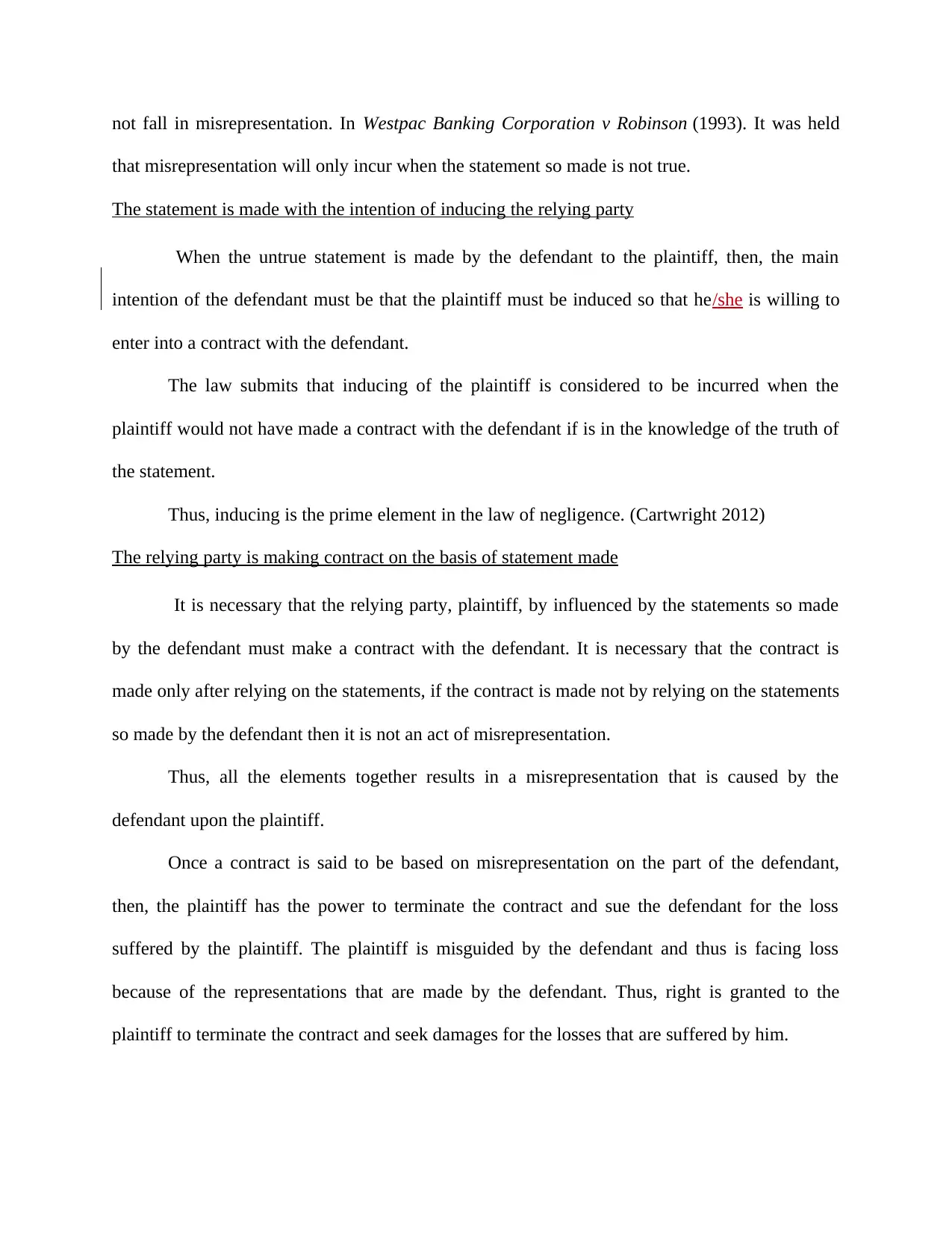
not fall in misrepresentation. In Westpac Banking Corporation v Robinson (1993). It was held
that misrepresentation will only incur when the statement so made is not true.
The statement is made with the intention of inducing the relying party
When the untrue statement is made by the defendant to the plaintiff, then, the main
intention of the defendant must be that the plaintiff must be induced so that he/she is willing to
enter into a contract with the defendant.
The law submits that inducing of the plaintiff is considered to be incurred when the
plaintiff would not have made a contract with the defendant if is in the knowledge of the truth of
the statement.
Thus, inducing is the prime element in the law of negligence. (Cartwright 2012)
The relying party is making contract on the basis of statement made
It is necessary that the relying party, plaintiff, by influenced by the statements so made
by the defendant must make a contract with the defendant. It is necessary that the contract is
made only after relying on the statements, if the contract is made not by relying on the statements
so made by the defendant then it is not an act of misrepresentation.
Thus, all the elements together results in a misrepresentation that is caused by the
defendant upon the plaintiff.
Once a contract is said to be based on misrepresentation on the part of the defendant,
then, the plaintiff has the power to terminate the contract and sue the defendant for the loss
suffered by the plaintiff. The plaintiff is misguided by the defendant and thus is facing loss
because of the representations that are made by the defendant. Thus, right is granted to the
plaintiff to terminate the contract and seek damages for the losses that are suffered by him.
that misrepresentation will only incur when the statement so made is not true.
The statement is made with the intention of inducing the relying party
When the untrue statement is made by the defendant to the plaintiff, then, the main
intention of the defendant must be that the plaintiff must be induced so that he/she is willing to
enter into a contract with the defendant.
The law submits that inducing of the plaintiff is considered to be incurred when the
plaintiff would not have made a contract with the defendant if is in the knowledge of the truth of
the statement.
Thus, inducing is the prime element in the law of negligence. (Cartwright 2012)
The relying party is making contract on the basis of statement made
It is necessary that the relying party, plaintiff, by influenced by the statements so made
by the defendant must make a contract with the defendant. It is necessary that the contract is
made only after relying on the statements, if the contract is made not by relying on the statements
so made by the defendant then it is not an act of misrepresentation.
Thus, all the elements together results in a misrepresentation that is caused by the
defendant upon the plaintiff.
Once a contract is said to be based on misrepresentation on the part of the defendant,
then, the plaintiff has the power to terminate the contract and sue the defendant for the loss
suffered by the plaintiff. The plaintiff is misguided by the defendant and thus is facing loss
because of the representations that are made by the defendant. Thus, right is granted to the
plaintiff to terminate the contract and seek damages for the losses that are suffered by him.
⊘ This is a preview!⊘
Do you want full access?
Subscribe today to unlock all pages.

Trusted by 1+ million students worldwide
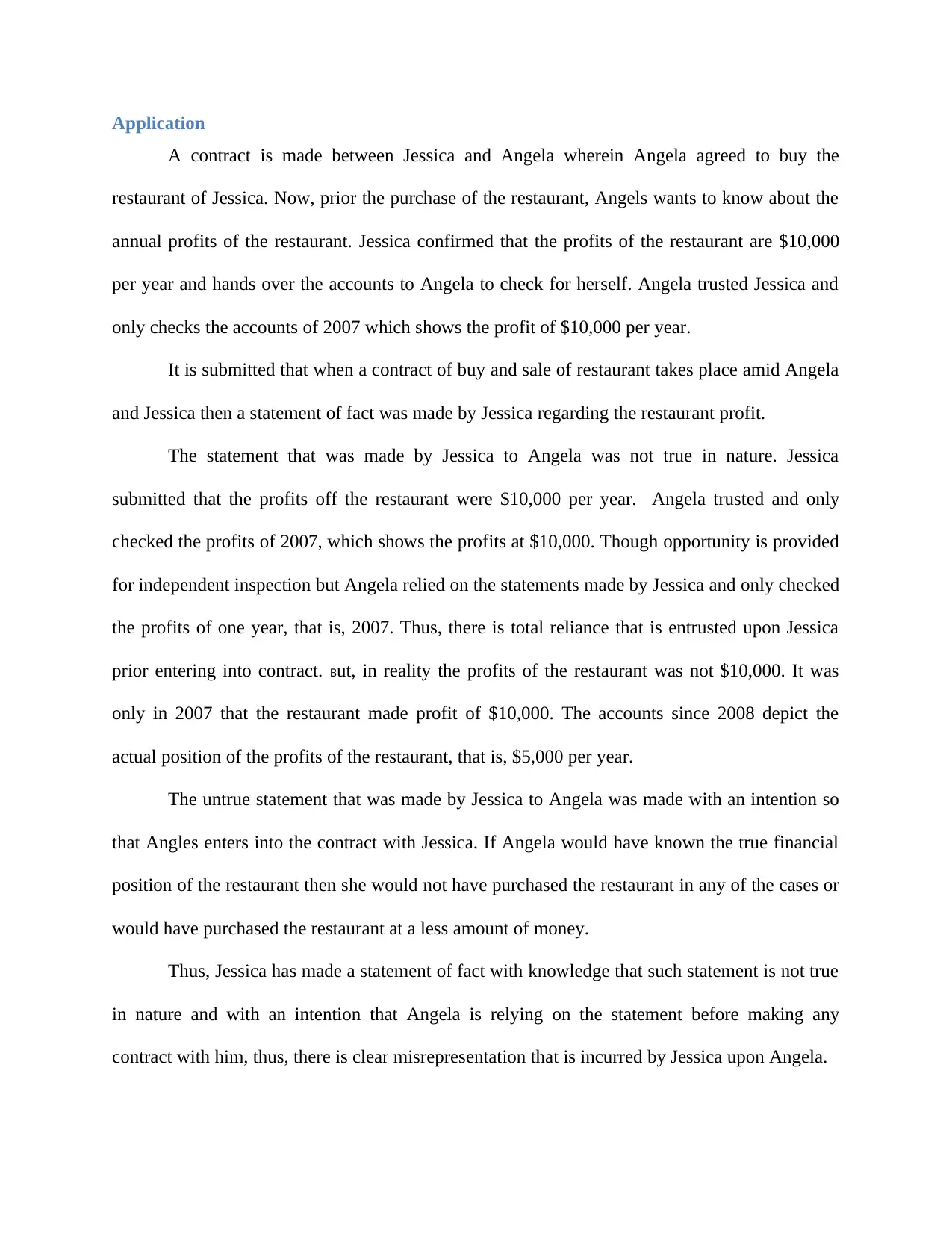
Application
A contract is made between Jessica and Angela wherein Angela agreed to buy the
restaurant of Jessica. Now, prior the purchase of the restaurant, Angels wants to know about the
annual profits of the restaurant. Jessica confirmed that the profits of the restaurant are $10,000
per year and hands over the accounts to Angela to check for herself. Angela trusted Jessica and
only checks the accounts of 2007 which shows the profit of $10,000 per year.
It is submitted that when a contract of buy and sale of restaurant takes place amid Angela
and Jessica then a statement of fact was made by Jessica regarding the restaurant profit.
The statement that was made by Jessica to Angela was not true in nature. Jessica
submitted that the profits off the restaurant were $10,000 per year. Angela trusted and only
checked the profits of 2007, which shows the profits at $10,000. Though opportunity is provided
for independent inspection but Angela relied on the statements made by Jessica and only checked
the profits of one year, that is, 2007. Thus, there is total reliance that is entrusted upon Jessica
prior entering into contract. But, in reality the profits of the restaurant was not $10,000. It was
only in 2007 that the restaurant made profit of $10,000. The accounts since 2008 depict the
actual position of the profits of the restaurant, that is, $5,000 per year.
The untrue statement that was made by Jessica to Angela was made with an intention so
that Angles enters into the contract with Jessica. If Angela would have known the true financial
position of the restaurant then she would not have purchased the restaurant in any of the cases or
would have purchased the restaurant at a less amount of money.
Thus, Jessica has made a statement of fact with knowledge that such statement is not true
in nature and with an intention that Angela is relying on the statement before making any
contract with him, thus, there is clear misrepresentation that is incurred by Jessica upon Angela.
A contract is made between Jessica and Angela wherein Angela agreed to buy the
restaurant of Jessica. Now, prior the purchase of the restaurant, Angels wants to know about the
annual profits of the restaurant. Jessica confirmed that the profits of the restaurant are $10,000
per year and hands over the accounts to Angela to check for herself. Angela trusted Jessica and
only checks the accounts of 2007 which shows the profit of $10,000 per year.
It is submitted that when a contract of buy and sale of restaurant takes place amid Angela
and Jessica then a statement of fact was made by Jessica regarding the restaurant profit.
The statement that was made by Jessica to Angela was not true in nature. Jessica
submitted that the profits off the restaurant were $10,000 per year. Angela trusted and only
checked the profits of 2007, which shows the profits at $10,000. Though opportunity is provided
for independent inspection but Angela relied on the statements made by Jessica and only checked
the profits of one year, that is, 2007. Thus, there is total reliance that is entrusted upon Jessica
prior entering into contract. But, in reality the profits of the restaurant was not $10,000. It was
only in 2007 that the restaurant made profit of $10,000. The accounts since 2008 depict the
actual position of the profits of the restaurant, that is, $5,000 per year.
The untrue statement that was made by Jessica to Angela was made with an intention so
that Angles enters into the contract with Jessica. If Angela would have known the true financial
position of the restaurant then she would not have purchased the restaurant in any of the cases or
would have purchased the restaurant at a less amount of money.
Thus, Jessica has made a statement of fact with knowledge that such statement is not true
in nature and with an intention that Angela is relying on the statement before making any
contract with him, thus, there is clear misrepresentation that is incurred by Jessica upon Angela.
Paraphrase This Document
Need a fresh take? Get an instant paraphrase of this document with our AI Paraphraser
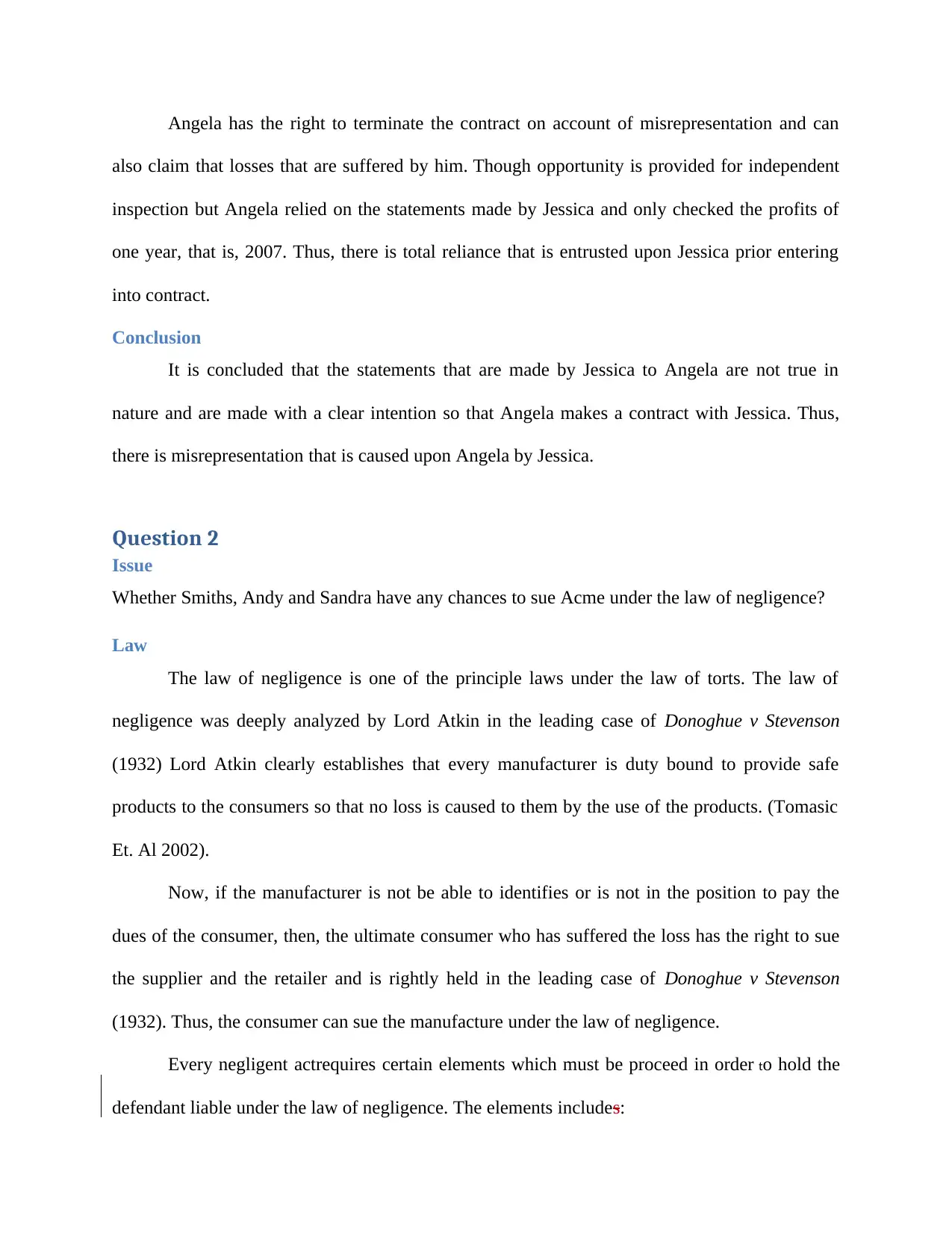
Angela has the right to terminate the contract on account of misrepresentation and can
also claim that losses that are suffered by him. Though opportunity is provided for independent
inspection but Angela relied on the statements made by Jessica and only checked the profits of
one year, that is, 2007. Thus, there is total reliance that is entrusted upon Jessica prior entering
into contract.
Conclusion
It is concluded that the statements that are made by Jessica to Angela are not true in
nature and are made with a clear intention so that Angela makes a contract with Jessica. Thus,
there is misrepresentation that is caused upon Angela by Jessica.
Question 2
Issue
Whether Smiths, Andy and Sandra have any chances to sue Acme under the law of negligence?
Law
The law of negligence is one of the principle laws under the law of torts. The law of
negligence was deeply analyzed by Lord Atkin in the leading case of Donoghue v Stevenson
(1932) Lord Atkin clearly establishes that every manufacturer is duty bound to provide safe
products to the consumers so that no loss is caused to them by the use of the products. (Tomasic
Et. Al 2002).
Now, if the manufacturer is not be able to identifies or is not in the position to pay the
dues of the consumer, then, the ultimate consumer who has suffered the loss has the right to sue
the supplier and the retailer and is rightly held in the leading case of Donoghue v Stevenson
(1932). Thus, the consumer can sue the manufacture under the law of negligence.
Every negligent actrequires certain elements which must be proceed in order to hold the
defendant liable under the law of negligence. The elements includes:
also claim that losses that are suffered by him. Though opportunity is provided for independent
inspection but Angela relied on the statements made by Jessica and only checked the profits of
one year, that is, 2007. Thus, there is total reliance that is entrusted upon Jessica prior entering
into contract.
Conclusion
It is concluded that the statements that are made by Jessica to Angela are not true in
nature and are made with a clear intention so that Angela makes a contract with Jessica. Thus,
there is misrepresentation that is caused upon Angela by Jessica.
Question 2
Issue
Whether Smiths, Andy and Sandra have any chances to sue Acme under the law of negligence?
Law
The law of negligence is one of the principle laws under the law of torts. The law of
negligence was deeply analyzed by Lord Atkin in the leading case of Donoghue v Stevenson
(1932) Lord Atkin clearly establishes that every manufacturer is duty bound to provide safe
products to the consumers so that no loss is caused to them by the use of the products. (Tomasic
Et. Al 2002).
Now, if the manufacturer is not be able to identifies or is not in the position to pay the
dues of the consumer, then, the ultimate consumer who has suffered the loss has the right to sue
the supplier and the retailer and is rightly held in the leading case of Donoghue v Stevenson
(1932). Thus, the consumer can sue the manufacture under the law of negligence.
Every negligent actrequires certain elements which must be proceed in order to hold the
defendant liable under the law of negligence. The elements includes:
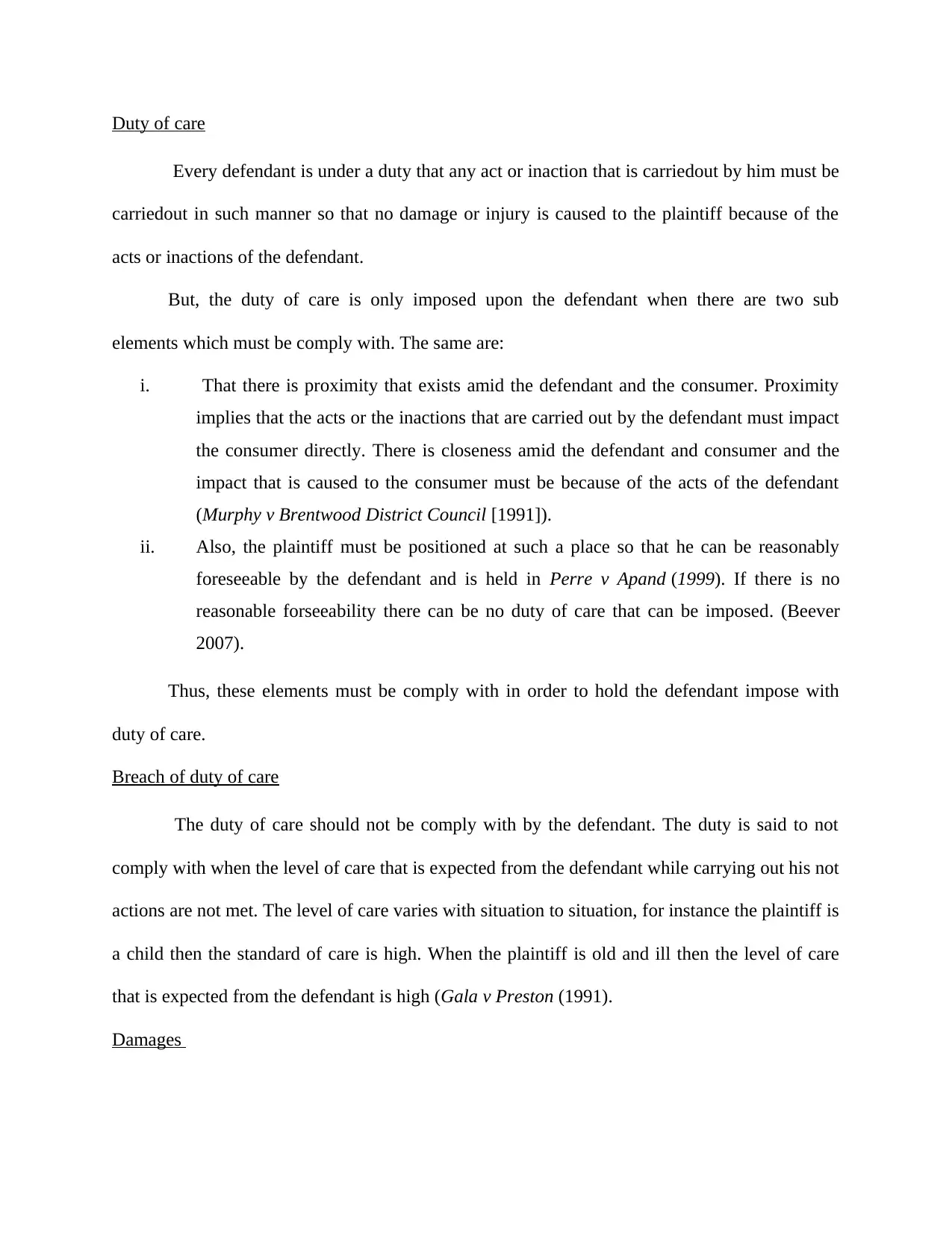
Duty of care
Every defendant is under a duty that any act or inaction that is carriedout by him must be
carriedout in such manner so that no damage or injury is caused to the plaintiff because of the
acts or inactions of the defendant.
But, the duty of care is only imposed upon the defendant when there are two sub
elements which must be comply with. The same are:
i. That there is proximity that exists amid the defendant and the consumer. Proximity
implies that the acts or the inactions that are carried out by the defendant must impact
the consumer directly. There is closeness amid the defendant and consumer and the
impact that is caused to the consumer must be because of the acts of the defendant
(Murphy v Brentwood District Council [1991]).
ii. Also, the plaintiff must be positioned at such a place so that he can be reasonably
foreseeable by the defendant and is held in Perre v Apand (1999). If there is no
reasonable forseeability there can be no duty of care that can be imposed. (Beever
2007).
Thus, these elements must be comply with in order to hold the defendant impose with
duty of care.
Breach of duty of care
The duty of care should not be comply with by the defendant. The duty is said to not
comply with when the level of care that is expected from the defendant while carrying out his not
actions are not met. The level of care varies with situation to situation, for instance the plaintiff is
a child then the standard of care is high. When the plaintiff is old and ill then the level of care
that is expected from the defendant is high (Gala v Preston (1991).
Damages
Every defendant is under a duty that any act or inaction that is carriedout by him must be
carriedout in such manner so that no damage or injury is caused to the plaintiff because of the
acts or inactions of the defendant.
But, the duty of care is only imposed upon the defendant when there are two sub
elements which must be comply with. The same are:
i. That there is proximity that exists amid the defendant and the consumer. Proximity
implies that the acts or the inactions that are carried out by the defendant must impact
the consumer directly. There is closeness amid the defendant and consumer and the
impact that is caused to the consumer must be because of the acts of the defendant
(Murphy v Brentwood District Council [1991]).
ii. Also, the plaintiff must be positioned at such a place so that he can be reasonably
foreseeable by the defendant and is held in Perre v Apand (1999). If there is no
reasonable forseeability there can be no duty of care that can be imposed. (Beever
2007).
Thus, these elements must be comply with in order to hold the defendant impose with
duty of care.
Breach of duty of care
The duty of care should not be comply with by the defendant. The duty is said to not
comply with when the level of care that is expected from the defendant while carrying out his not
actions are not met. The level of care varies with situation to situation, for instance the plaintiff is
a child then the standard of care is high. When the plaintiff is old and ill then the level of care
that is expected from the defendant is high (Gala v Preston (1991).
Damages
⊘ This is a preview!⊘
Do you want full access?
Subscribe today to unlock all pages.

Trusted by 1+ million students worldwide
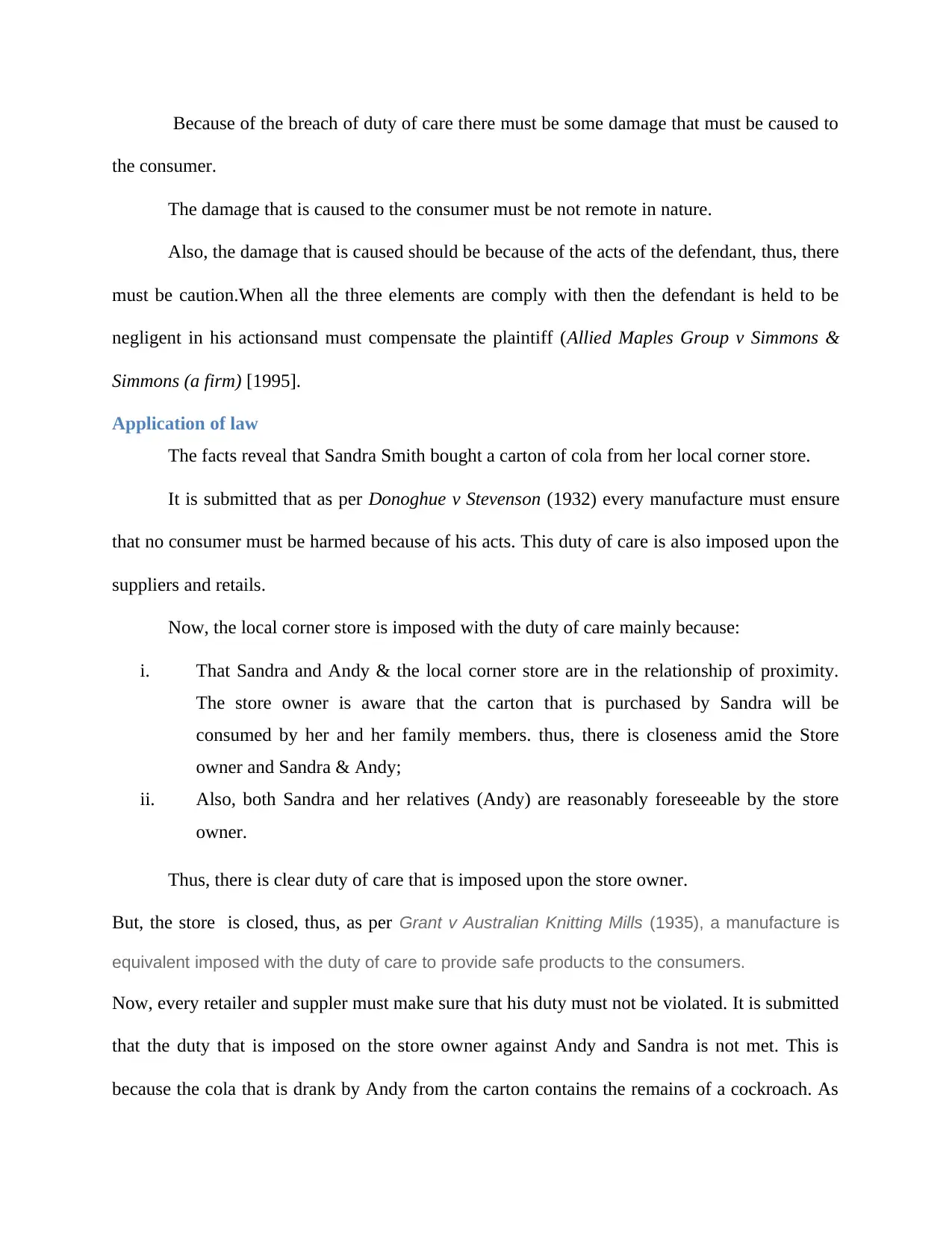
Because of the breach of duty of care there must be some damage that must be caused to
the consumer.
The damage that is caused to the consumer must be not remote in nature.
Also, the damage that is caused should be because of the acts of the defendant, thus, there
must be caution.When all the three elements are comply with then the defendant is held to be
negligent in his actionsand must compensate the plaintiff (Allied Maples Group v Simmons &
Simmons (a firm) [1995].
Application of law
The facts reveal that Sandra Smith bought a carton of cola from her local corner store.
It is submitted that as per Donoghue v Stevenson (1932) every manufacture must ensure
that no consumer must be harmed because of his acts. This duty of care is also imposed upon the
suppliers and retails.
Now, the local corner store is imposed with the duty of care mainly because:
i. That Sandra and Andy & the local corner store are in the relationship of proximity.
The store owner is aware that the carton that is purchased by Sandra will be
consumed by her and her family members. thus, there is closeness amid the Store
owner and Sandra & Andy;
ii. Also, both Sandra and her relatives (Andy) are reasonably foreseeable by the store
owner.
Thus, there is clear duty of care that is imposed upon the store owner.
But, the store is closed, thus, as per Grant v Australian Knitting Mills (1935), a manufacture is
equivalent imposed with the duty of care to provide safe products to the consumers.
Now, every retailer and suppler must make sure that his duty must not be violated. It is submitted
that the duty that is imposed on the store owner against Andy and Sandra is not met. This is
because the cola that is drank by Andy from the carton contains the remains of a cockroach. As
the consumer.
The damage that is caused to the consumer must be not remote in nature.
Also, the damage that is caused should be because of the acts of the defendant, thus, there
must be caution.When all the three elements are comply with then the defendant is held to be
negligent in his actionsand must compensate the plaintiff (Allied Maples Group v Simmons &
Simmons (a firm) [1995].
Application of law
The facts reveal that Sandra Smith bought a carton of cola from her local corner store.
It is submitted that as per Donoghue v Stevenson (1932) every manufacture must ensure
that no consumer must be harmed because of his acts. This duty of care is also imposed upon the
suppliers and retails.
Now, the local corner store is imposed with the duty of care mainly because:
i. That Sandra and Andy & the local corner store are in the relationship of proximity.
The store owner is aware that the carton that is purchased by Sandra will be
consumed by her and her family members. thus, there is closeness amid the Store
owner and Sandra & Andy;
ii. Also, both Sandra and her relatives (Andy) are reasonably foreseeable by the store
owner.
Thus, there is clear duty of care that is imposed upon the store owner.
But, the store is closed, thus, as per Grant v Australian Knitting Mills (1935), a manufacture is
equivalent imposed with the duty of care to provide safe products to the consumers.
Now, every retailer and suppler must make sure that his duty must not be violated. It is submitted
that the duty that is imposed on the store owner against Andy and Sandra is not met. This is
because the cola that is drank by Andy from the carton contains the remains of a cockroach. As
Paraphrase This Document
Need a fresh take? Get an instant paraphrase of this document with our AI Paraphraser
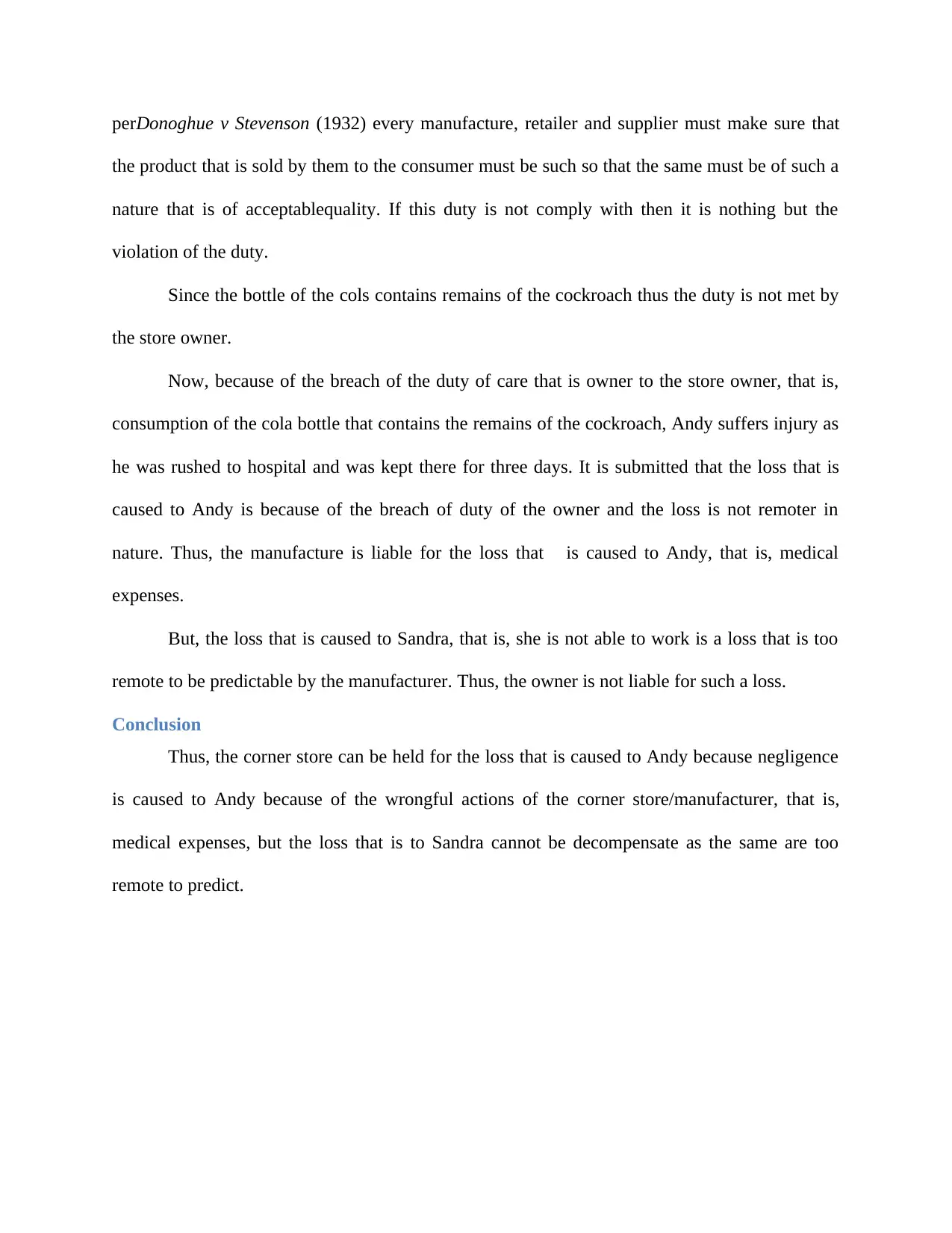
perDonoghue v Stevenson (1932) every manufacture, retailer and supplier must make sure that
the product that is sold by them to the consumer must be such so that the same must be of such a
nature that is of acceptablequality. If this duty is not comply with then it is nothing but the
violation of the duty.
Since the bottle of the cols contains remains of the cockroach thus the duty is not met by
the store owner.
Now, because of the breach of the duty of care that is owner to the store owner, that is,
consumption of the cola bottle that contains the remains of the cockroach, Andy suffers injury as
he was rushed to hospital and was kept there for three days. It is submitted that the loss that is
caused to Andy is because of the breach of duty of the owner and the loss is not remoter in
nature. Thus, the manufacture is liable for the loss that is caused to Andy, that is, medical
expenses.
But, the loss that is caused to Sandra, that is, she is not able to work is a loss that is too
remote to be predictable by the manufacturer. Thus, the owner is not liable for such a loss.
Conclusion
Thus, the corner store can be held for the loss that is caused to Andy because negligence
is caused to Andy because of the wrongful actions of the corner store/manufacturer, that is,
medical expenses, but the loss that is to Sandra cannot be decompensate as the same are too
remote to predict.
the product that is sold by them to the consumer must be such so that the same must be of such a
nature that is of acceptablequality. If this duty is not comply with then it is nothing but the
violation of the duty.
Since the bottle of the cols contains remains of the cockroach thus the duty is not met by
the store owner.
Now, because of the breach of the duty of care that is owner to the store owner, that is,
consumption of the cola bottle that contains the remains of the cockroach, Andy suffers injury as
he was rushed to hospital and was kept there for three days. It is submitted that the loss that is
caused to Andy is because of the breach of duty of the owner and the loss is not remoter in
nature. Thus, the manufacture is liable for the loss that is caused to Andy, that is, medical
expenses.
But, the loss that is caused to Sandra, that is, she is not able to work is a loss that is too
remote to be predictable by the manufacturer. Thus, the owner is not liable for such a loss.
Conclusion
Thus, the corner store can be held for the loss that is caused to Andy because negligence
is caused to Andy because of the wrongful actions of the corner store/manufacturer, that is,
medical expenses, but the loss that is to Sandra cannot be decompensate as the same are too
remote to predict.
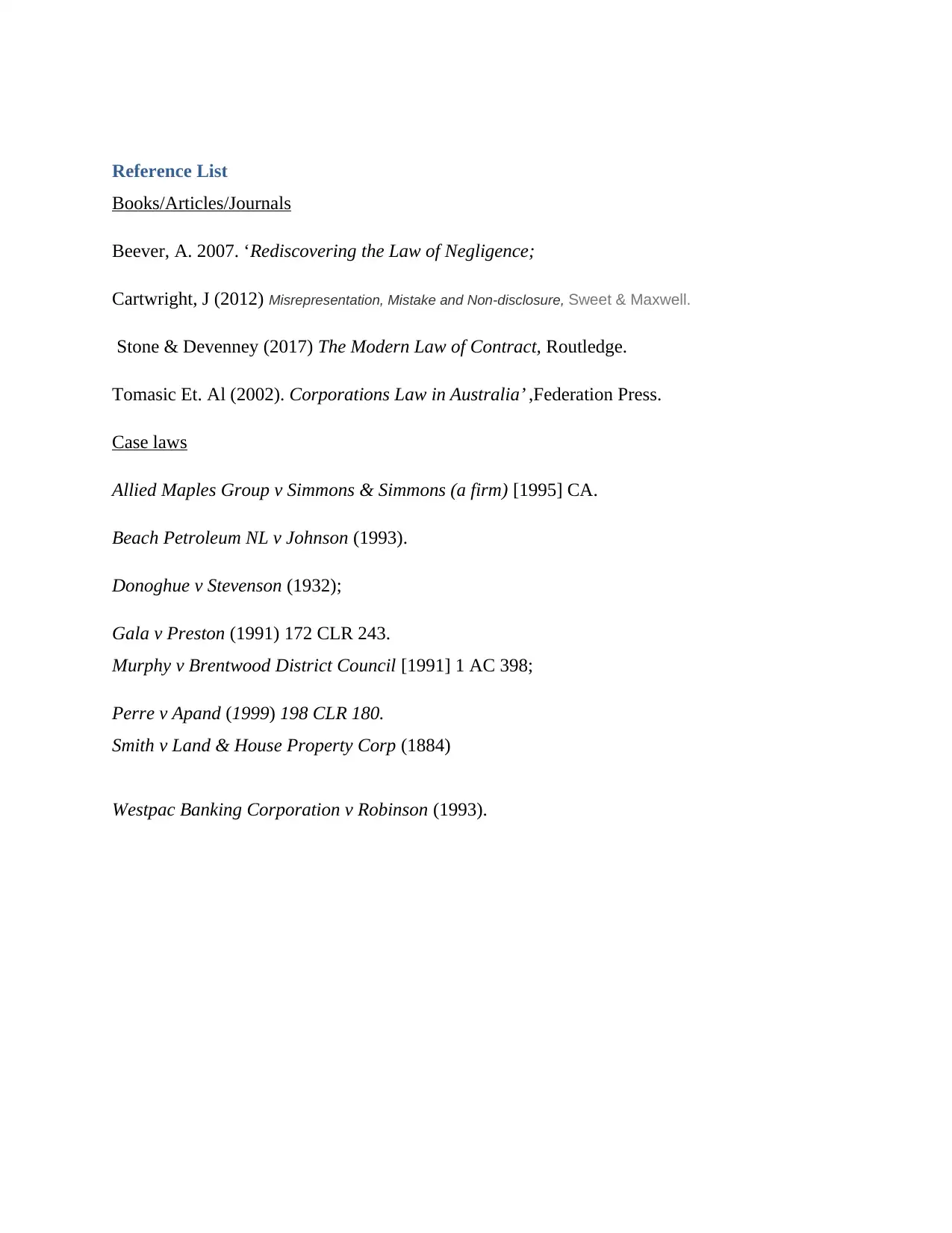
Reference List
Books/Articles/Journals
Beever, A. 2007. ‘Rediscovering the Law of Negligence;
Cartwright, J (2012) Misrepresentation, Mistake and Non-disclosure, Sweet & Maxwell.
Stone & Devenney (2017) The Modern Law of Contract, Routledge.
Tomasic Et. Al (2002). Corporations Law in Australia’ ,Federation Press.
Case laws
Allied Maples Group v Simmons & Simmons (a firm) [1995] CA.
Beach Petroleum NL v Johnson (1993).
Donoghue v Stevenson (1932);
Gala v Preston (1991) 172 CLR 243.
Murphy v Brentwood District Council [1991] 1 AC 398;
Perre v Apand (1999) 198 CLR 180.
Smith v Land & House Property Corp (1884)
Westpac Banking Corporation v Robinson (1993).
Books/Articles/Journals
Beever, A. 2007. ‘Rediscovering the Law of Negligence;
Cartwright, J (2012) Misrepresentation, Mistake and Non-disclosure, Sweet & Maxwell.
Stone & Devenney (2017) The Modern Law of Contract, Routledge.
Tomasic Et. Al (2002). Corporations Law in Australia’ ,Federation Press.
Case laws
Allied Maples Group v Simmons & Simmons (a firm) [1995] CA.
Beach Petroleum NL v Johnson (1993).
Donoghue v Stevenson (1932);
Gala v Preston (1991) 172 CLR 243.
Murphy v Brentwood District Council [1991] 1 AC 398;
Perre v Apand (1999) 198 CLR 180.
Smith v Land & House Property Corp (1884)
Westpac Banking Corporation v Robinson (1993).
⊘ This is a preview!⊘
Do you want full access?
Subscribe today to unlock all pages.

Trusted by 1+ million students worldwide
1 out of 9
Related Documents
Your All-in-One AI-Powered Toolkit for Academic Success.
+13062052269
info@desklib.com
Available 24*7 on WhatsApp / Email
![[object Object]](/_next/static/media/star-bottom.7253800d.svg)
Unlock your academic potential
Copyright © 2020–2025 A2Z Services. All Rights Reserved. Developed and managed by ZUCOL.





